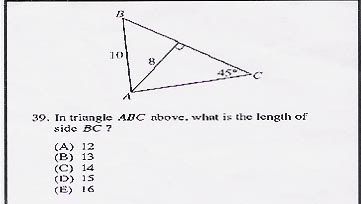I am trying to figure out i know its a squared plus b squared = c squared.
I will guess that, by "it", you mean "the Pythagorean Theorem", with "c" being the length of the hypotenuse of the right triangle.
I will guess that, by "it", you mean "the triangle ABC", rather than either of the right triangles. However, since the Pythagorean Theorem only applies to right triangles, I understand that I may be wrong here. In either case, to what, specifically, are you attempting to apply the Theorem?
but i am confused i know you do the square root
I will guess that, by "do the square root", you mean "one solves the equation for 'c=' by taking the square root of either side of the equation generated by the Theorem". However, this does not explain why you instead took the square roots of each
term rather than of each
side. This was why I'd asked whether you'd taken any algebra or geometry yet, since you'd have learned how to work with the Theorem in one or both of these classes.
Since you have not responded to that query, I will guess that you are asking for instruction on how to use the Theorem to solve for side lengths. In this case, please try
here.
the other figure i believe is 27 ft and 9 inches is that correct.
I will guess that, by "the other figure", you mean "Exercise 19" and that, by "is", you mean "the perimeter of the figure is". However, since your answer value can be obtained by adding the lengths of only two of the walls (rather than, as was explained to you earlier,
all of the walls), I must be mistaken.
To learn what "perimeter" is and how to determine it from labelled polygons, try
here.
Please study
at least two lessons from each of the links before attempting either exercise. If you still get stuck, please reply
clearly showing your steps and explaining your reasoning (like I've displayed in my replies). Thank you!


